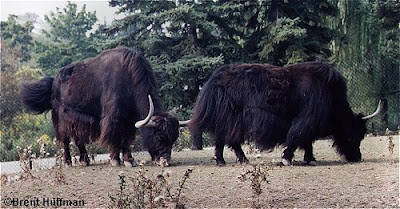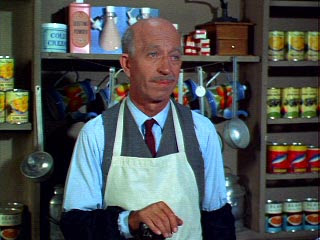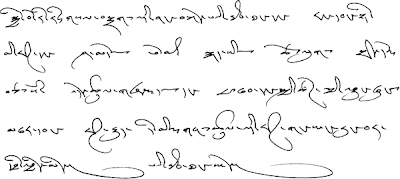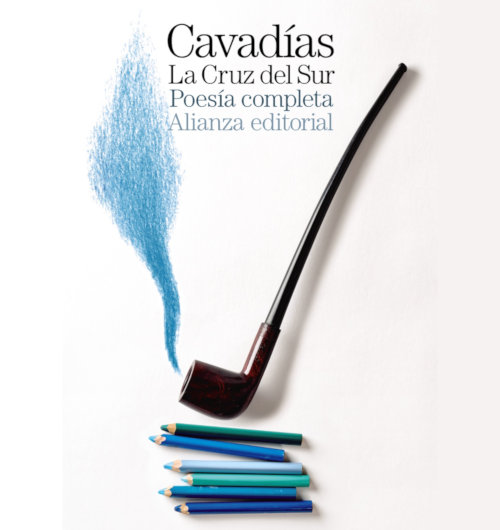People in my neighborhood
Leh, Ladakh
Well, I finally saw a yak. A great big beautiful black and white yak - or maybe a Dri (female yak). It had no  horns; perhaps that is a trait of a Dri. It's absolutely huge, like a shaggy black-and-white tank, and is placidly grazing on the newly-harvested field down the lane from my guest house. (Wait, I think I used that phrase last week...placidly grazing camels!)
horns; perhaps that is a trait of a Dri. It's absolutely huge, like a shaggy black-and-white tank, and is placidly grazing on the newly-harvested field down the lane from my guest house. (Wait, I think I used that phrase last week...placidly grazing camels!)
Since I can't get original photos onto the site from here, here is a stock photo.
In Ladakhi bioculture, nothing is ever wasted (even human waste gets composted for about a year, till it is non toxic, then used on fruit trees). So, after they finish cutting all the wheat or barley, the Ladakhis put the cows and yaks out to graze on the stubble and finish the job for them.
What was surprising was that it was a yak, a real yak and not a Dzo or Dzomo (yak-cow hybrid). In the last episode I related that the valleys are now still too hot for the yaks. But there has been a slight dip in the weather and perhaps this one was transferred from the upper elevations down to town.
Closing up shop
All the Kashmiri merchants are packing up and going back to Srinagar. If you are ever in doubt about which merchants are Kashmiri, they are the annoying ones that sit in front of their shoppes all day annoying you. I really love the contradiction between the obsequious, wheedling, oily tone of voice ("come have a look in my small shoppe madame???") and the resentful, frustrated and condescending facial expressions (which say, "you stupid foreigner, step inside like a bug into my spiderweb"). They never, ever seem to "get" that harassment does not equal salesmanship. Then they wonder why the foreigners and other tourists all go to the Tibetan and Ladakhi merchants. These other merchants give sincere smiles, and leave them alone to browse in silence. What a concept!
The fact that something does not work and never has worked is absolutely no obstacle to its continued practice in India. Doing things The Way They've Always Been Done is far more important than getting results.
I actually worked out a roundabout path from the guest house into town that bypasses all but one Kashmiri merchant on the Changspa road. Other foreign tourists I talked to had done the same.
Also, in case you need to identify them further, Kashmiri shoppes always have names like "Kashmiri Emporium," "Ancient Arts Antique Emporium," and my favourites: "Useless Wali Arts Emporium" and "Age of Old Era."
One shoppe I like to frequent because the owner does not resort to sidewalk touting is the cornily-named Antique Heaven, just off the main bazaar. Mr. Bhatt will not pressure me, will gladly show me anything I'm interested in with no pressure to buy, and loves to talk about Ladakh, Kashmir and the local political situations. He is extremely laid back, and a great source of information. I even go by his shoppe just to say hello (and as any experienced Indian traveller will tell you, that is saying a lot about a Kashmiri merchant).
Loads of restaurants are listed in the Lonely Planet, but for good service, good food, a good bathroom and the absolute best 360 degree view I go to Leh View Restaurant. The three-storey climb to the terrace was a real huffer and puffer when I first arrived, but now I am acclimated and trot up the stairs with ease. Everything I ate there (Vegetable Biryani for 70Rs or $1.50 reeks aromatically of cloves and all kinds of exotic spices) was great, the service is fast, it always looks clean and you can watch cricket games on TV in the downstairs room. Not to mention, one of the only decent bathrooms in town. A great bathroom here means, "the door locks, it doesn't stink and there is a sink - with SOAP!"
The rooftop terrace has stunning views of Leh Palace, Tsemo Gompa, the mountains, the golden-roofed Vihara across the street and even Shanti Stupa several miles away.
I noticed that during last week's Pakistan vs. India games, a lot of the Kashmiri Muslims (as opposed to Ladakhi Muslims or any other Indian Muslims) in various restaurants, shops etc. refused to stand for the Indian national anthem. They were rooting for Pakistan (they held their cheering at bay till the Indian tourists left the establishment in question, though). I thought maybe I was mistaken and asked them (when no one else was around) "who were you cheering for?" "Pakistan."
As soon as India won, the Kashmiris all poured out onto the street (all over Leh town) cursing. I was walking homeward when this happened and saw the crowds on the streets. I saw a Ladakhi kid start teasing a Kashmiri guy and decided to get home fast before something got out of hand. That is exactly the kind of thing that could start a rumble in an Indian neighborhood.
Ladakhi Libations
While in Ladakh, or anywhere in Kashmir, don't miss Kashmiri Kawa (also spelt Kehwa, Kahwa, etc). It's a Kashmiri hot drink made with saffron, crushed almonds, crushed cashews, cinnamon and sometimes green tea leaves (depends on where you go and who you ask). Leh View has very yummy Kahwa that is heavy on cinnamon. Only 15Rs (about thirty cents) for a glass.
A delicious drink that is a bit harder to come by is chang, the home-made Ladakhi barley beer. My guesthouse owner made it for a special puja last week, and I loved it - especially with a handful of tsampa or barley flour thrown in, making it like a grainy alcoholic milkshake. The Belgian guests at the dinner looked at me like I was some kind of intrepid adventurer just for trying it.
Another great unique Ladakhi drink is Seabuckthorn juice (aka Leh Berry juice or tsetsalu juice), reputed to have the highest level of Vitamin C and antioxidants of, well, anything. The juice of the tart, bright-orange berries, which grow only here in Ladakh, are mixed with a bit of sugar and served as a tangy drink. The Dzomsa, besides being a place to refill your water bottle, sells fresh glasses of this juice for 15Rs. Dzomsa also sells dried sweet apricots and roasted crunch, which make a great road snack.
I love the name of Hot Million Sweets and Snacks on the main bazaar - and they serve a really thick Punjabi-style lassi for 15Rs. However, the best samosas belong to Neha Sweets around the corner from the Big Mosque. One samosa, five rupees - you can pig out for 20Rs and a glass of tea to wash it down is another 5Rs. I like the big open picture windows, where I can watch people stroll by and even look up at the ancient Leh Palace on the hilltop.
The Big Mosque is a major neighborhood landmark. The muezzin's call is an easy way to tell the time of day. The mosque was built in 1666 as part of a deal between the Ladakhi Buddhist king (I think it was Sengge Namgyal) and the Mughals. The Mughals promised to defend independent Ladakh against Tibet, for a certain price. I have read in various places that the original Big Mosque (Jama Masjid) was built in a unique Central Asian-Ladakhi architectural style. More recently, it's been renovated to include onion domes, minarets and other more "Arabic" features.
My favourite internet place is Ancient Tracks Cyber Cafe right at the corner of Fort Road and the Main Bazaar. They are the only internet place downtown (or that I ever saw anywhere for that matter) who have a generator power backup. That means, when the power cuts out (at least once a day here), you can stay online. The Tibetan operators will offer you free tea if you stay long enough, especially during dinner time. I like the fact that it's run by women only. It completely changes the feel of the place. Plus, they are open the latest - open till 11pm.
The most centrally located pharmacy and medical shoppe- and a bit of Himalayan history - is Het Ram Vinay Kumar, whose Punjabi family has been trading here for about four generations - "since before the time of the Chinese aggression," Mr Kumar himself told me. He's the stern-looking man behind the desk. He told me that National Geographic featured the store in a story about exiled Tibetans in a 1960 issue.
In classic general store tradition, Het Ram sells a  bit of everything, as do the other large old-timey general stores on the block (they used to call them Dry Goods Stores). Their jumbles of Tibetan khatag scarves, burlap sacks of spices, fabric for heavy goncha dresses, coils of rope, candles for power outages, bins of potatos and dusty boxes of L'oreal hair colour give the comfortable feeling: "we can scrounge up anything you need...just give us a minute." I felt like Mr Drucker from Green Acres would peep out from behind the counter.
bit of everything, as do the other large old-timey general stores on the block (they used to call them Dry Goods Stores). Their jumbles of Tibetan khatag scarves, burlap sacks of spices, fabric for heavy goncha dresses, coils of rope, candles for power outages, bins of potatos and dusty boxes of L'oreal hair colour give the comfortable feeling: "we can scrounge up anything you need...just give us a minute." I felt like Mr Drucker from Green Acres would peep out from behind the counter.
That's it! I finally realized who the Kashmiri Merchants remind me of....Green Acres' Mr. Haney.
.....
By the book
The most comprehensive bookstore in town is Ladakh Bookstore, just underneath Leh View Restaurant. Strolling through their aisles I feel almost like I'm in Delhi, or Barnes & Noble, and they accept credit cards (a rarity in Ladakh). However, they close up shop and leave for Punjab for the winter some time at end of September.
A more constant presence in the community is Leh Ling Books (Main Bazaar road), which is much more homespun but has a lot of the same stuff, in addition to kids' school supplies, blank notebooks, ink pens, maps, and greeting cards. Other great bookstores in town, some of which sell second-hand volumes, include the Bookworm and Otdan Books.
However, for a Ladakhi language-learning book - the kind used by primary school beginners - I searched in vain. The big bookstores had tourist pocket-phrase books in English script, and big unwieldy "Ladakhi-English-Urdu dictionaries."
I hit no less than five local stationery and bookshops (including shops that sold all kinds of Hindi, English and even Urdu learning books for schoolkids) and not ONE had a Ladakhi or even Tibetan script-learning book (Tibetan and Ladakhi share an alphabet). They all directed me to "Main Bazaar."
Surely Leh Ling would have it, I thought. Nope. Only one man in town, they said, "still" sold Ladakhi script-learning books - Thubsten Sanfan in the old bazaar.
I knew that there had been a struggle in the recent past about including Ladakhi language in the school curriculum - as opposed to Urdu, the official state language of J&K, but I thought it had emerged semi-victorious. Semi-, because now most public school education is in English medium, and the children can choose either Ladakhi, Urdu or (I think) Hindi as a second language. Ladakhi is not some obscure language - a great many of the signs are in Ladakhi Bodyig script. Most of the population is Buddhist and the script is the same for Tibetan, the sacred language of the area, which all Tibetan Buddhists should know how to read. I never thought it would be so difficult to find a Ladakhi script primer.
The old bazaar is a sort of more authentic, less exposed Main Bazaar, an alleyway running exactly parallel to the Main road but without the Kashmiri merchants, travel agents and junk stores. There are only real neighborhood stores here - tailors making salwar-kameez and Ladakhi gonchas, haircutters set up in tiny booths "for gents only" giving 40Rs cuts or shaves, a few butchers, a thangka-framer (a thangka is a sacred Buddhist scroll that must be mounted on brocade fabric), one tailor specializing in monk's maroon robes. I had to ask several times for Thubstan Sanfan, since there was no signboard in either Ladakhi or English.
Thubstan Sanfan Stationery was a tiny, dusty cubbyhole with nothing but the long skinny Tibetan scriptures on the shelves - nothing, not even a shopkeeper there, either. The shoppe was wide open and no caretaker to be seen. I thumbed through the mysterious books, deciphering an occasional letter, then decided to ask a neighbor where the proprietor was. The neighboring shopkeeper ran across the way to yet another shop, and brought back Thubstan Sanfan.
Mr Sanfan is a bit of a one-man industry. He publishes Ladakhi language calendars, reading primers, script primers, religious books and astrological references, in addition to running the religious supplies and thangka-mounting shop across the road. For 10Rs (about a quarter) I bought a bright yellow "Ladakhs Book Part I" which introduces me to the Tibetan/Ladakhi script.
Already, I can read simple one- or two-syllable words...but I haven't yet mastered the silent prefixes! As a spelling system, they are almost as annoying and illogical as English. Practicing Ladakhi script over and over is a good way to lull myself to sleep.
And for extra fun, there are actually 2 Tibetan scripts... U-chen (the everyday one I am learning) and the classical script, Gyuk Yig, sort of an elegant abstract version of U-chen. If I wanted to be an expert on Tibetan scripture, and thank god I don't, I would have to learn both.
Angmo will help me. She is the adorable nine year old niece of my guesthouse owners. I am really going to miss this place. Green Acres, we are there....

Above, and below, are examples of U-chen and GyukYig Scripts. What's written here is the 1st Article of the Universal Declaration of Human Rights, which reads:
All human beings are born free and equal in dignity and rights. They are endowed with reason and conscience and should act towards one another in a spirit of brotherhood.















1 comment:
Darkhorse in Nashville writes:
Your posting of Mr. Drucker and Mr. Haney is a searing comic touch, just like ya, balanced with the great description of "jumbles of Tibetan khatag scarves, burlap sacks of spices, fabric for heavy goncha dresses, coils of rope, candles for power outages, bins of potatos and dusty boxes of L'oreal hair colour".
Post a Comment